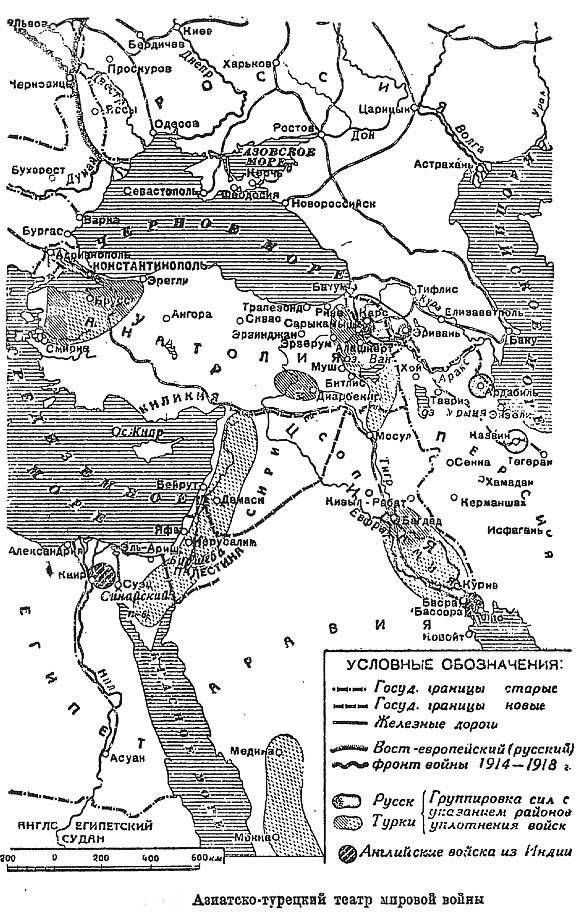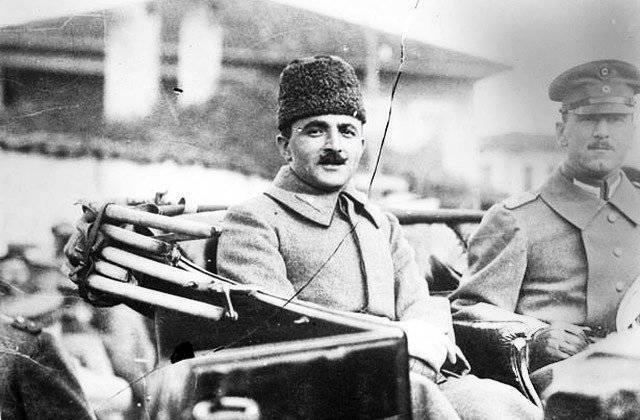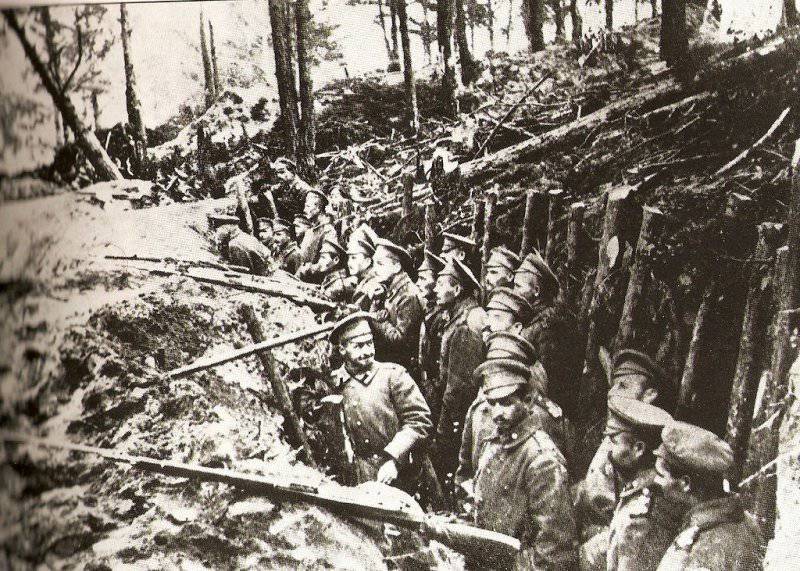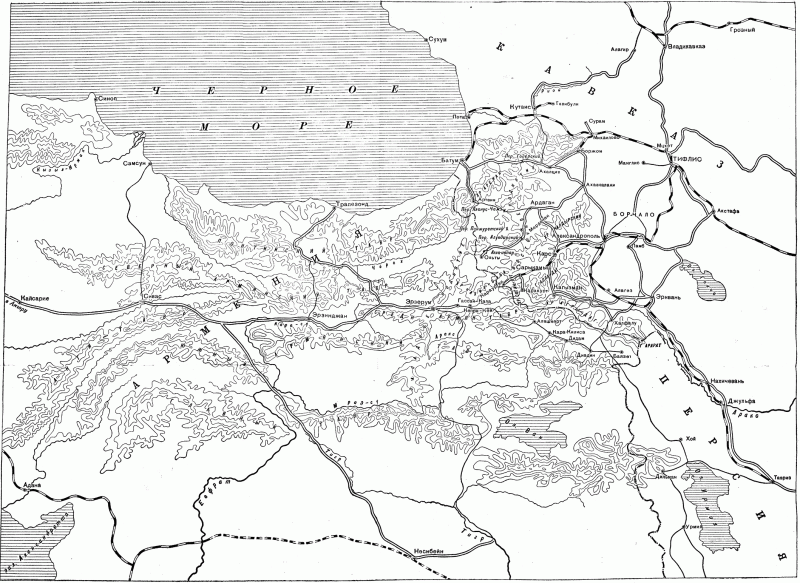Sarykamysh defeat
100 years ago, 9 (22) December 1914, the Sarykamysh battle began. The Turkish commander-in-chief, Enver Pasha, a student of the German military school and a big fan of the German doctrine, planned to carry out a deep detour and to destroy the Russian Caucasian Army with a powerful blow. Turkish Napoleon Enver Pasha dreamed of making the second Tannenberg of the Russian army, which allowed him to seize all the Transcaucasus, and then hoped to raise the rebellion of all Muslims of Russia and spread the fire of the war to the North Caucasus and Turkestan (Central Asia). The military catastrophe in the Caucasus would force the Russian command to transfer additional forces from the Eastern front to the Caucasian front, which made it easier for Germany and Austria-Hungary. After the victory in the war with Russia, the Turkish rulers hoped to annex all the Turkic and Muslim ethnic groups to the Ottoman Empire - in the Caucasus, in the Caspian region, Turkestan, the Volga region and even Western Siberia.
However, the Russian Caucasian troops gave a brutal lesson to the Ottomans - almost the entire 90-thousand. 3-I Turkish army, the most powerful army of Turkey, was destroyed. From it there were miserable bits and pieces. The threat of a Turkish invasion of the Caucasus has been eliminated. The Russian Caucasian Army opened its way deep into Anatolia.
prehistory
In the first three months of the war, the Ottoman Empire formally maintained neutrality. However, Istanbul, even before the start of the war, entered into close military-political relations with the German Empire. Part of the Turkish leadership, which insisted on an alliance with the Entente, lost, since France and Russia showed indifference to Turkey, believing that its business is neutrality. As a result, the pro-German group took the dominant position.
Ottoman Government 2 August 1914 r concluded a secret military alliance with the German Empire. While the question of Turkey’s participation in the war remained open, the Young Turk government took advantage of the situation to strengthen its position inside the country by abolishing the surrender regime. That was the name of the regime in which foreigners were withdrawn from the operation of local jurisdiction and submitted to the jurisdiction of their countries. In mid-October, 1914 issued decrees on the elimination of capitulation privileges.
The military alliance with Germany obliged Turkey to side with the Germans in the outbreak of the war. The Turkish fleet was placed under the control of the German naval mission led by Admiral Souchon. The Turkish army - the only real force in the country and the support of the Young Turk regime - was in the hands of German advisers led by General Liman von Sanders. The chief of the Turkish General Staff was Colonel Bronsar von Shellendorf. Germanic cruisers “Goeben” and “Breslau” entered the straits. Germany granted Porte large loans, finally tying it to itself. 2 August Turkey began mobilization. The army was brought to enormous size - 900 thousand soldiers. The mobilization of hundreds of thousands of people, transport and working livestock, endless extortion for the needs of the army — all this has undermined the Turkish economy, which was already in crisis.
When the plan of the German Blitzkrieg collapsed, and the first failures were noted on the Western and Eastern fronts, Germany increased the pressure on the Young Turk triumvirate (the Young Turk leaders Enver Pasha, Talaat Pasha and Jemal Pasha). To speed up the events, the Turkish “hawks”, led by Enver Pasha, with the full understanding of the Germans, organized an attack of the German-Turkish naval forces on Sevastopol and other Russian ports. This led to the fact that Russia 2 on November 1914 declared war on the Ottoman Empire. 11 November 1914. Turkey declared war on Britain and France. As a result, a new regional center of war emerged, which led to the appearance of several fronts — the Caucasus, Persian, Mesopotamian, Arabian, Suez, and others.
England and France had their interest in this confrontation. They used the question of the Straits and Constantinople as a “bait” for Russia (and for Greece) using its resources. At the same time, the West in reality did not intend to give Russia the straits and Constantinople, tried in every way to delay the war with Turkey.
The war was given a protracted and indecisive character, hindered the Russian army in the implementation of its strategic tasks. It was more profitable for Russia to crush Turkey with one decisive blow, which the allies could help. However, the British avoided interaction with the Russian Caucasian Army in every possible way. At the same time, the British demanded assistance. Petersburg went to meet the allies, as well as on the Eastern Front. Russian troops, exposing themselves to the disastrous effects of the local climate, in 1916, rushed to help the British troops surrounded by the Turks south of Baghdad. And the British, in order to disrupt the landing operation of the Russians in the Bosporus zone, first deliberately missed the German cruisers “Goeben” and “Breslau” into the Dardanelles, turning the Turkish fleet into a real combat unit, and then in 1915, they launched the barren Dardanelles operation. This operation was undertaken by the Entente primarily because of the fear that the Russians would be able to independently seize Constantinople and the straits. As a result, due to the contradictions of the great powers, which deepened as the war developed, the coordination of the actions of the allied armies in the Middle East was never achieved. This allowed the German military specialists, who headed the Turkish armed forces, to fend for a long time the scattered attempts of the Anglo-French forces to seize the Asian possessions of Porta and restrain the pressure of Russia.
The Ottoman Empire was in a state of profound socio-economic and political crisis. Economy and finance were under the control of foreigners, the country was a de facto semi-colony. The industry was in its infancy. Before the outbreak of the First World War, Turkey lost two wars. After losing to Italy the Tripolitanian war, Turkey lost Tripolitania and Cyrenaica (modern Libya). The defeat in the First Balkan War led to the loss of almost all European possessions, except Istanbul and its vicinity. The national liberation movement, combined with the poverty of the overwhelming majority of the population (peasantry), undermined the country from the inside. The Young Turks who seized power in 1908 compensated for failures in foreign and domestic politics with the ideology of Pan-Islamism and Pan-Turkism. Victory in the war was supposed to give the Ottoman Empire a new impetus to life, to turn it into a world power.
All the forces of the Russian Empire were distracted by hard struggle in the European theater. The defense of the Caucasus was seriously weakened. Enver Pasha and his supporters did not hesitate anymore, they believed that Turkey had the “finest hour” - now or never. The Ottoman Empire could have recovered everything it had lost from the Kucuk-Kaynardzhiysky world 1774, and even more. And the lot was cast, the Ottoman Empire attacked Russia, signing a death sentence for itself.
Read more about the situation of Turkey on the eve of the war in the articles:
100 years ago the Ottoman Empire launched a war against Russia
How Turkish national liberals led the Ottoman Empire to collapse
Plans for the construction of the Great Turan and the domination of the "superior race"
The first strikes of Turkey: “Sevastopol wake-up”, battles at Bayazet and Kepreek
The first blows of Turkey: “Sevastopol wake-up”, battles at Bayazet and Kepreek. 2 part
Plans and forces of the parties
Taking into account the fact that at the beginning of the war, Turkey maintained neutrality, 2 army corps and 5 Cossack divisions were sent to the front from the Caucasus (two thirds of all forces). Therefore, after the Ottoman Empire entered the war, the Russian grouping in the Caucasus was seriously weakened. The troops remaining in the Caucasus received the task of providing two main communications that connected the Transcaucasus with European Russia: the Baku-Vladikavkaz railway and the Tiflis-Vladikavkaz highway (the so-called Georgian Military Highway). At the same time, Russian troops were supposed to protect an important industrial center - Baku. To do this, it was supposed to conduct active defense, invade Turkish Armenia, smash the advanced troops of the Turkish army, gain a foothold on the occupied frontier mountainous frontiers, thereby preventing the Ottoman invasion of the Russian Caucasus.
The Russian command planned to deliver the main blow on the Erzurum direction, providing it with simultaneous movement of separate detachments in the Olti and Kagyzman directions. The coastal (Black Sea coast) and Azerbaijani direction was considered the most vulnerable sector of the Caucasian front, because on the eve of the war Russian troops occupied Persian Azerbaijan. Therefore, to ensure the flanks were allocated separate groups of troops.
With the beginning of the war in the Transcaucasus, only one 1-th Caucasian corps remained under the command of General George Berhman (20-th and 39-th infantry divisions), fortified by the only secondary division of the Caucasian district - 66-th infantry. The 2-I Caucasian Rifle Brigade was stationed in Persia. These forces reinforced separate formations - 2 Brigade Redemption, 3 1 / 2 Cavalry Divisions and Border Units. In September, the weak 2 th Turkestan corps (4 th and 5 th Turkestan rifle brigades) were redeployed in the Caucasus, whose headquarters had already been transferred to the South-Western Front. The official commander in chief of the Russian army was the Caucasian governor, Illarion Vorontsov-Dashkov. However, he was already old and asked to resign. In fact, his military adviser, General Alexander Myshlaevsky, controlled everything. The chief of staff of the Caucasian Army was a combat general Nikolai Yudenich, who would eventually lead the Russian troops and achieve brilliant successes on the Caucasian front.
By the beginning of the war, Russian troops were dispersed on the 720-kilometer front from the Black Sea to Persia. In total, 5 groups were formed: 1) The seaside detachment of General Elshin was given the task of covering Batum; 2) Oltinsky detachment of General Istomin covered the flank of the main forces in the Kara direction; 3) The main forces of the Russian army (Sarykamysh detachment) under the command of General Berhman (1-I Caucasian Corps) were located on the Sarykamysh-Erzurum direction; 4) The Erivan unit of General Oganovsky stood in the Bayazet direction; 5) The Azerbaijani detachment of General Chernozubov was stationed in Northern Persia. The 2 th Turkestan Corps and the Kars garrison (formed 3 th Caucasian Rifle Brigade) were in the army reserve. By the beginning of hostilities, the total number of Russian army in the Caucasus had reached 153 battalions, 175 hundreds, 17 demining companies, 350 field guns and 6 battalions of serf artillery.
At the beginning of the war, the Russian command made a number of mistakes, which affected the results of the first serious battle. Thus, the Russian command dispersed its troops in separate detachments on a broad mountain front, highlighting the excess forces in the secondary Erivan-Azerbaijani sector and deploying an army reserve far away from the front. As a result, the Ottomans had an advantage on the main Erzurum direction, concentrating 50% of all forces, while the Russians opposed them to 33% of their forces.

The Turkish war plan was based on the instructions of the German officers. According to the plan of the German-Turkish command, the Turkish armed forces were to: 1) tie down the Russian Caucasian army, not allowing large units to be transferred from its composition to the European theater; 2) prevent the British from occupying Iraq; 3) interrupt navigation on the Suez Canal, for which it was necessary to seize the adjacent area; 4) keep the straits and Constantinople; 5) try to neutralize the Black Sea Fleet; 6) when entering the war of Romania on the German side, the Turks had to support the Romanian army in the invasion of the Ukraine.
Since the beginning of the war, Turkey has deployed seven armies: 1) 1-I, 2-I and 5-I armies defended Constantinople and the straits; 2) The 3-I army, the strongest, was deployed against Russia and had to cover the Persian direction; 3) The 4 Army defended the shores of the Mediterranean, Palestine and Syria, and was given the task of occupying Suez; 4) 6-I army defended Iraq; 5) The Arabian army solved the task of protecting the northern coast of the Red Sea.
3-I army under the command of Gassan-Izeta-pasha, whose chief of staff was the German major Guzé, received the task of defeating the Russian troops from Sarykamysh, and then, putting a barrier in front of Kars, to capture Ardahan and Batum. Batum was to become the operational base for further offensive in the Caucasus. At the same time, the Ottomans planned to raise a widespread uprising of the local Muslim population against the "Russian invaders." In the event that the Russian army is the first to go on the offensive, the Turkish 3 army should have prevented a deep Russian invasion of Anatolia, go on the counteroffensive. When the Russian troops attacked Erzurum direction, the enemy troops planned to encircle and destroy east of the Erzerum fortress, which made it possible to implement broad plans for the occupation of the Caucasus.
The Turkish 3 army consisted of the 9 (17, 28 and 29 infantry divisions), 10 (30, 31 and 32 division) and 11 (18) I, the 33 and 34 divisions of the army corps, 1 cavalry and several Kurdish divisions, border and gendarme troops. In addition, to strengthen the army from Mesopotamia, the 37 th infantry division of the 13 corps was being deployed. By the beginning of hostilities, 3 Army forces reached 100 battalions, 165 squadrons and Kurdish hundreds, 244 guns.
Each Turkish division had in its composition three infantry regiments, an artillery regiment, a sapper company, a cavalry squadron and one reserve depot. The regiments consisted of three battalions and a machine-gun company (4 machine guns). The artillery regiments included 2-3 field or mountain battalions for 2-3 four-gun batteries (up to 24 guns). In the Turkish division was approximately 8 thousand fighters, and they were about our brigade. In the Turkish corps there were three divisions, 3 artillery regiment, 1 cavalry regiment, howitzer division and sapper battalion. In total, there were about 25 thousand soldiers in the corps with 84 guns.
The main forces of the 3 Turkish Army (9 and 11 Corps) were concentrated in the Erzerum area. The 10 body was originally located near Samsun. It was planned to use it as an amphibious landing ship for landing in Novorossia, if the German-Turkish fleet achieved supremacy on the sea or repel the expected landing of Russian troops. It was not possible to achieve supremacy at sea, and the landing of the Russian landing force turned out to be misinformation, which the Russian General Staff skillfully deceived the enemy. Therefore, the 10 body also began to be transferred to the Erzerum area.
At the beginning of the war, the main grouping of the 3 Army was focused on the Erzurum direction. This group, in the event of an offensive by the Russian troops, was to meet them in the Gassan-Kala and Keprikei (Kepri-Kay) areas. Parts of the forces had to counterattack from the front, the other part - to make a detour from the north and south. In the direction of Azerbaijan, the Turkish command deployed border units, gendarmes and Kurdish units. Kurdish troops also stood at the front of Bayazet, Alashkert.
Caucasian theater of war
The beginning of the fighting. Keprikeyskoe battle
The war from the first day took a maneuverable character. The Russian troops, located on the Erzurum, Altin and Erivan directions, on October 19 (November 1) invaded Turkey. The 39 Infantry Division of the Berchman Corps moved into the Passinskaya Valley and, continuing the advance in the Erzurum direction, on October 25 (November 7) captured the Kepri-Kei position. It was a well-fortified position, but there were few Turkish troops here. However, one and a half of our divisions of the 1 of the Caucasian corps were faced with six Turkish divisions of the 9 and 11 of the corps. A tough battle ensued.
Meanwhile, the Erivan detachment successfully overturned the border Turkish-Kurdish units and captured Bayazet and Karakilissa. Russian troops occupied the Alashkert valley, securing the left flank of the Sarykamysh group of Berkhman and pulling the arriving forces of the 13 Turkish corps. The Erivan detachment was transformed into the 4 Caucasian Corps. Successfully acted and the Azerbaijani squad. The detachment of General Chernozubov as part of the 4 Caucasian Cossack Division and the 2 Caucasian Rifle Brigade subdued the neighboring tribes, defeated and drove the Turkish-Kurdish forces that entered the western regions of Persia. Russian troops occupied areas of Northern Persia, Tabriz and Urmia, and began to threaten the Ottoman Empire from the south-east. However, for the development of the first success of the troops was not enough.
The commander of the 3 of the Turkish army, Gassan-Izet Pasha, threw his troops into a counteroffensive. In the meantime, the early mountain winter began in the Caucasus, it became cold, and a snowstorm began. October 26 (November 8) from the snowstorm surpassed the superior forces of the Turkish troops, overturned the Russian avant-garde and hit the main forces of the Russian corps. In the fierce four-day battle of Kepri-Kee, the Russian corps was forced to retreat to the Araks valley. The Russian command hastily redeployed parts of the 2 of the Turkestan Corps to the aid of Berhman. In addition, the 2 th Plastun brigade was transferred to the main line. Reinforcements counterattacked the enemy. The squadrons on the left flank broke and forced the 33 Turkish Infantry Division to retreat, then moved to the night on the 7 (20) of November on the ice in the Araks river in the water and raided the enemy rear lines. Soon the Turkish offensive was stopped, and the front stabilized. Both sides began to prepare the troops for the winter.
At the same time there were battles on the coastal direction. The Primorsky detachment, the 264 Infantry Regiment of St. George, several hundred border guards and a battalion of squads, was scattered on a huge front in the wilderness. He had to reassure the rebellious Muslim population of the Chorokhi region and restrain the offensive of the 3 of the Turkish Infantry Division deployed from Constantinople, supported by irregular troops. The seaside detachment was reinforced by the 19 Turkestan regiment sent to Batum.
Plans for "Turkish Napoleon"
After the Battle of Keprikei, both sides went on the defensive and hoped for a calm winter. To fight in the winter in the mountains was extremely difficult, and in some cases impossible. However, at the end of November, Enver Pasha and the head of the Turkish General Staff, Colonel von Schellendorf, arrived in Erzerum. "Turkish Napoleon" (Enver's energetic actions and success during the 1908 revolution made him extremely popular in Turkey, he was even compared to Napoleon) decided not to withdraw troops to winter apartments, but using the first success and superiority in the forces to go on a decisive offensive, surround and destroy the weak Caucasian army.
As a result, Turkey could occupy Transcaucasia and develop an offensive in the North Caucasus. A loud victory could lead to a large-scale uprising of the Muslim population in the Caucasus and in Turkestan. Enver Pasha dreamed that victory in the war with Russia would lead to the creation of the great "Turan Kingdom" - a great empire from Suez to Samarkand and Kazan. Enver himself saw himself as the lord of the renewed Ottoman Empire. It was a cherished dream of his life. He began to carry out his adventure with great determination, without being embarrassed by objective problems, such as the onset of winter, when there was usually a lull in the Caucasus. The commander of the 3 Army Gassan-Izet protested against this adventure and resigned. Enver himself led the army.

Enver Pasha accompanied by a German officer
To be continued ...


Information